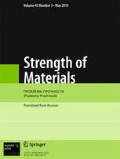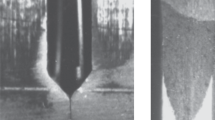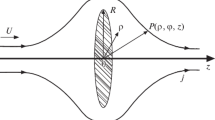Conclusions
-
1.
An expression for the diagonal components of the tensor (residual resistance) of a specimen with cracks having ellipsoidal form was obtained for the case of high temperatures and large deformations. It was shown that with cracks having the same orientation the longitudinal and transverse components are different. In the absence of cracks the component z of the residual resistance tensor corresponding most closely to the experimental conditions (insignificant dilation ξ ∼ 10−3–10−5, small c axis of crack of diskshaped form, with anisometry parameter α = IIc/4b) parallel to the direction of the current) has the following form for a conductor with specific resistance ρ0:
$$\Delta \rho _{zz}^c = \frac{{\rho _0 \xi }}{{2\alpha }}.$$In addition, when ξ = α there is the possibility of simultaneously determining the average dimensions of the cracks and their concentration.
-
2.
A comparison was made of the residual electrical resistance created by point defects, dislocations, and cracks during plastic deformation of metals; the theoretical results obtained were also compared with experiment. It was found that during plastic deformation of aluminum the additional resistance observed in a series of experiments can be explained by the contribution of N = 109 cm−3 disk-shaped cracks.
-
3.
With alternating current the presence of cracks in nonmetallic poor conductors causes unequal dispersion of the imaginary and real parts of the complex specific conductivity. For metals the capacity susceptance of the cracks is insignificant.
-
4.
On the basis of the skin effect a method was developed for calculating the concentration of cracks by measuring the ohmic resistance of the conductor.
Similar content being viewed by others
Literature cited
S. N. Zhurkov, Vestnik Akad. Nauk SSSR, No.11 (1957); Neorganicheskie Materialy, No.3 (1967).
V. I. Vladimirov, A. N. Orlov, and V. A. Petrov, Phys. St. Sol., No.47 (1971).
V. I. Vladimirov, A. N. Orlov, and V. A. Petrov. Phys. St. Sol., No.42 (1970).
S. N. Zhurkov, V. A. Marikhin, and A. I. Slutsker, Fiz. Tverd. Tela, No. 1 (1959).
V. S. Kuksenko, A. I. Slutsker, and A. L. Yastrebinskii, Fiz. Tverd. Tela, No. 9 (1967).
V. A. Zakrevskii, V. S. Kuksenko, et al., Fiz. Tverd. Tela, No. 11 (1969).
M. A. Gezalov, V. S. Kuksenko, and A. I. Slutsker, Fiz. Tverd. Tela, No. 12 (1970).
A. M. Leksovskii and V. R. Regel', in: Materials of a Conference on Metal Fatigue [in Russian], Nauka, Moscow (1967).
A. M. Leksovskii, O. F. Kirienko, and V. R. Regel', Mekhanika Polimerov, No.1 (1966).
I. A. Oding and Yu. P. Liberov, Izv. Akad. Nauk SSSR, Otd. Tekh. Nauk, Metallurgiya i Gornoe Delo, No. 2 (1964).
R. I. Garber, I. V. Obreimov, and L. M. Polyakov, Dokl. Akad. Nauk SSSR, No. 108 (1956).
R. I. Garber and L. M. Polyakov, Fiz. Tverd. Tela, No. 5 (1960).
B. Ya. Levin, V. I. Betekhtin, et al., Fiz. Tverd. Tela, No. 12 (1970).
D. L. Dexter, Phys. Rev., No. 103 (1956).
A. N. Stroh, Phil. Mag., No.3 (1957).
I. K. Ovchinnikov, in: Course of Lectures for Prospecting Geologists. Field Theory [in Russian], Izd. Sverdlovskogo Gornogo Instituta, Sverdlovsk (1962).
L. E. Kaechle and A. S. Tetelman, Acta Met., No.17 (1969).
N. F. Mott and H. Jones, Theory of Properties of Metals and Alloys, Clarendon Press, Oxford (1936).
J. Friedel, Dislocations [Russian translation], Mir, Moscow (1967).
J. G. Rider and C. T. B. Foxon, Phil. Mag., No. 122 (1966).
Fucoi Uun, Phil. Mag., No. 168 (1969).
S. E. Ceresara, H. Elkholy, and T. Federighi, Phys. St. Sol., No. 8 (1965).
L. D. Landau and E. M. Lifshits, Electrodynamics of Continuous Media [in Russian], GITTL, Moscow (1957).
W. Hellental, R. Lucke, and H. Ostholt, Zeitschrift fur Angewandte Physik, No. 3 (1969).
E. Johnston and H. Johnston, Rev. Scient. Instrum., No.6 (1964).
I. E. Tamm, Principles of Electricity [Russian translation], GITTL, Moscow (1957).
Author information
Authors and Affiliations
Additional information
Translated from Problemy Prochnosti, No.4, pp.70–74, April, 1973.
Rights and permissions
About this article
Cite this article
Vladimirov, V.I., Lupashki, R.G. Investigation of cracks by the electrical resistance method. Strength Mater 5, 465–470 (1973). https://doi.org/10.1007/BF00762820
Received:
Issue Date:
DOI: https://doi.org/10.1007/BF00762820




